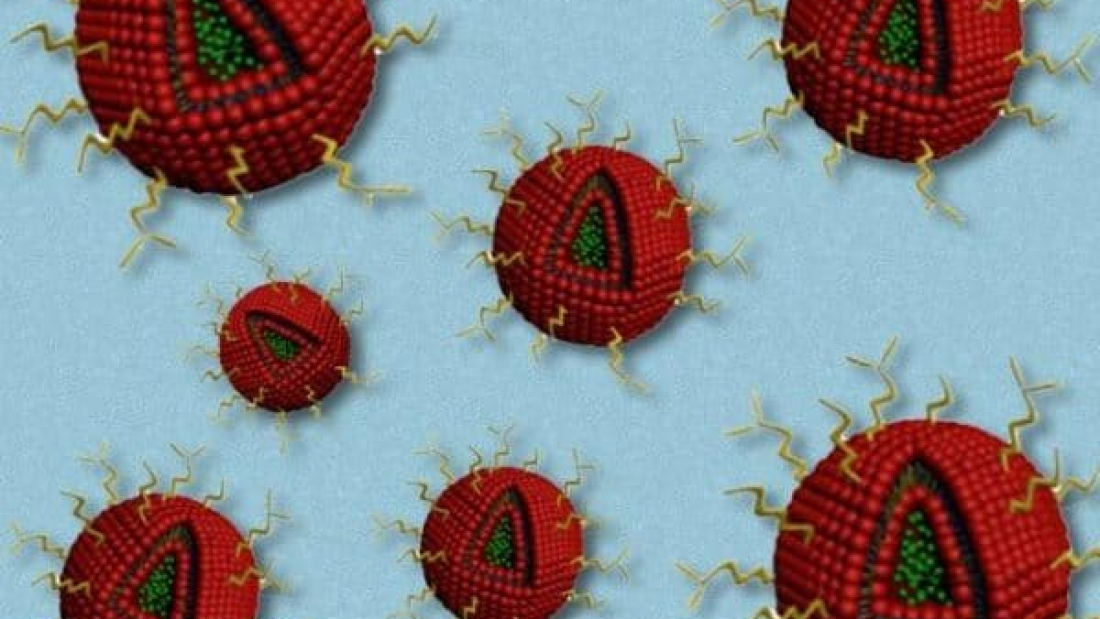Glioblastoma multiforme, a type of brain tumor, is one of the most difficult-to-treat cancers. Only a handful of drugs are approved to treat glioblastoma, and the median life expectancy for patients diagnosed with the disease is less than 15 months.
To adapt the particles to treat brain tumors, the researchers had to come up with a way to get them across the blood-brain barrier, which separates the brain from circulating blood and prevents large molecules from entering the brain.
Building on prior work from Floyd and Yaffe on the DNA-damage response of tumors, the researchers packaged temozolomide into the inner core of the liposomes, and in the outer shell they embedded an experimental drug called a bromodomain inhibitor, aiming to enhance glioblastoma treatment. Bromodomain inhibitors are believed to interfere with cells’ ability to repair DNA damage. By combining these two drugs, the researchers created a one-two punch that first disrupts tumor cells’ DNA repair mechanisms, then launches an attack on the cells’ DNA while their defenses are down.
The researchers tested the nanoparticles in mice with glioblastoma tumors and showed that after the nanoparticles reach the tumor site, the particles’ outer layer degrades, releasing the bromodomain inhibitor JQ-1. About 24 hours later, temozolomide is released from the particle core.
The researchers’ experiments revealed that drug-delivering nanoparticles coated with transferrin were far more effective at shrinking tumors than either uncoated nanoparticles or temozolomide and JQ-1 injected into the bloodstream on their own. The mice treated with the transferrin-coated nanoparticles survived for twice as long as mice that received other treatments.
“This is yet another example where the combination of nanoparticle delivery with drugs involving the DNA-damage response can be used successfully to treat cancer,” says Michael Yaffe, a David H. Koch Professor of Science and member of the Koch Institute, who is also an author of the paper.
In the mouse studies, the researchers found that animals treated with the targeted nanoparticles experienced much less damage to blood cells and other tissues normally harmed by temozolomide. The particles are also coated with a polymer called polyethylene glycol (PEG), which helps protect the particles from being detected and broken down by the immune system. PEG and all of the other components of the liposomes are already FDA-approved for use in humans.
“Our goal was to have something that could be easily translatable, by using simple, already approved synthetic components in the liposome,” Lam says. “This was really a proof-of-concept study [showing] that we can deliver novel combination therapies using a targeted nanoparticle system across the blood-brain barrier.”
JQ-1, the bromodomain inhibitor used in this study, would likely not be well-suited for human use because its half-life is too short, but other bromodomain inhibitors are now in clinical trials.
The researchers anticipate that this type of nanoparticle delivery could also be used with other cancer drugs, including many that have never been tried against glioblastoma because they couldn’t get across the blood-brain barrier.
“Because there’s such a short list of drugs that we can use in brain tumors, a vehicle that would allow us to use some of the more common chemotherapy regimens in brain tumors would be a real game-changer,” Floyd says. “Maybe we could find efficacy for more standard chemotherapies if we can just get them to the right place by working around the blood-brain barrier with a tool like this.”
The research was funded by the Koch Institute Frontier Research Program; a KI Quinquennial Cancer Research Fellowship; the Bridge Project, a partnership between the Koch Institute and the Dana-Farber/Harvard Cancer Center; and the Koch Institute Support (core) Grant from the National Cancer Institute.
Source: http://news.mit.edu/2018/tiny-particles-could-help-fight-brain-cancer-0524


Add a Comment